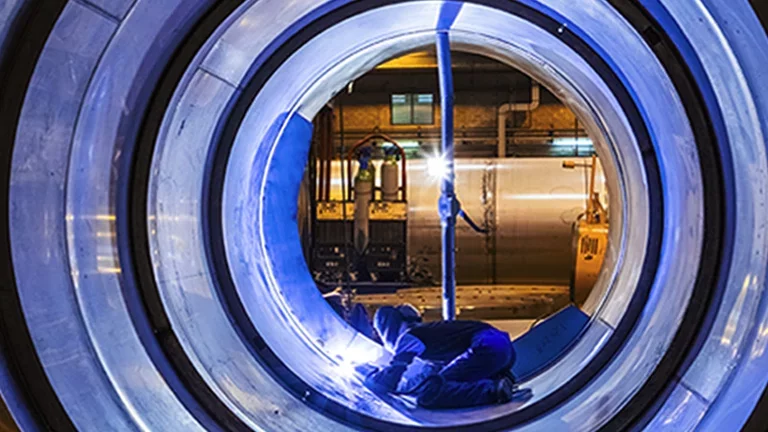
Ethylene
- C2H4
- CAS Number 74-85-1
- UN1962 (gas)
- UN1038 (refrigerated liquid)
Click & drag to move the 3D molecule
Liquid / Gas Volumes
Calculate the volume or mass of a quantity of gas or liquid
Liquid Phase
At boiling point at 1.013 bar
Gas Phase
In standard conditions (1.013 bar, 15°C)
Physical Properties
Molecule phase diagram showing the transition phases between solid, liquid and gas as a function of temperature and pressure
-
- Molar mass 28.050 g/mol
- Content in dry air /
-
Critical Point
- Temperature 9.19 °C
- Pressure 50.41 bar
- Density 214.15 kg/m³
-
Triple Point
- Temperature -169.16 °C
- Pressure 1.22E-3 bar
Pressure 1.013 bar
| Latent heat of fusion (at melting point) | 119.45 kJ/kg |
| Melting point | - 169.15 °C |
Pressure 1.013 bar
| Boiling point | - 103.77 °C |
| Latent heat of vaporization (at boiling point) | 482.41 kJ/kg |
| Liquid density (at boiling point) | 567.65 kg/m3 |
| Compressibility factor Z | 9.9247E-1 |
| Cp/Cv ratio γ | 1.2651 |
| Gas density (at boiling point) | 2.087 kg/m3 |
| Gas density | 1.2608 kg/m3 |
| Gas/(liquid at boiling point) equivalent | 450.23 vol/vol |
| Heat capacity Cp | 1.459 kJ/(kg.K) |
| Heat capacity Cv | 1.1533 kJ/(kg.K) |
| Specific gravity | 0.98 |
| Specific volume | 7.932E-1 m3/kg |
| Thermal conductivity | 17.369 mW/(m.K) |
| Vapor pressure | 41.0148 bar |
| Viscosity | 9.4697E-5 Po |
| Compressibility factor Z | 9.9361E-1 |
| Cp/Cv ratio γ | 1.2535 |
| Gas density | 1.1938 kg/m3 |
| Gas/(liquid at boiling point) equivalent | 475.5 vol/vol |
| Heat capacity Cp | 1.5048 kJ/(kg.K) |
| Heat capacity Cv | 1.2008 kJ/(kg.K) |
| Specific gravity | 0.98 |
| Specific volume | 8.377E-1 m3/kg |
| Thermal conductivity | 19.099 mW/(m.K) |
| Viscosity | 9.98E-5 Po |
| Compressibility factor Z | 9.9426E-1 |
| Cp/Cv ratio γ | 1.2461 |
| Gas density | 1.153 kg/m3 |
| Gas/(liquid at boiling point) equivalent | 492.32 vol/vol |
| Heat capacity Cp | 1.5375 kJ/(kg.K) |
| Heat capacity Cv | 1.2338 kJ/(kg.K) |
| Specific gravity | 0.98 |
| Specific volume | 8.676E-1 m3/kg |
| Thermal conductivity | 20.326 mW/(m.K) |
| Viscosity | 1.0318E-4 Po |
Applications
Examples of uses of this molecule in Industry and Healthcare

Chemicals
In term of quantity produced, ethylene is the most important organic chemical. Ethylene is the feedstock in the manufacture of the most important polymer: polyethylene. It is also converted to ethylene oxide, it is a precursor to ethylene glycol, ethylbenzene, styrene and to various kinds of polyethylene, to ethylene dichloride and to vinyl chloride.

Food
Ethylene is used to stimulate and regulate the ripening of various fruits, such as tomatoes and bananas.

Metal fabrication
Ethylene is used in oxycutting.
Safety & Compatibility
GHS02
Flammable
GHS04
Gas under pressure
GHS07
Health hazards
Autoignition Temperature, Flammability Limits & Flash Point
Europe (according to EN1839 for Limits and EN 14522 for autoignition temperature)
| Autoignition temperature (Chemsafe) | 440 °C |
| Lower flammability limit (IEC 80079-20-1) | 2.4 vol% |
| Upper flammability limit (IEC 80079-20-1) | 32.6 vol% |
US (according to ASTM E681 for Limits and ASTM E659 for autoignition temperature)
| Autoignition temperature (NFPA 325) | 450 °C |
| Lower flammability limit (NFPA 325) | 2.7 vol% |
| Upper flammability limit (NFPA 325) | 36 vol% |
Odor
Sweet
Metals
| Aluminium | Satisfactory |
| Brass | Satisfactory |
| Monel | No data |
| Copper | No data |
| Ferritic Steel | Satisfactory |
| Stainless steel | Satisfactory |
| Zinc | No data |
| Titanium | No data |
Plastics
| Polytetrafluoroethylene | Satisfactory |
| Polychlorotrifluoroethylene | Satisfactory |
| Polyvinylidene fluoride | Satisfactory |
| Polyvinyl chloride | Satisfactory |
| Ethylene tetrafluoroethylene | No data |
| Polycarbonate | No data |
| Polyamide | Satisfactory |
| Polypropylene | Satisfactory |
Elastomers
| Butyl (isobutene- isoprene) rubber | Satisfactory |
| Nitrile rubber | Satisfactory |
| Chloroprene |
Swelling
Not recommended
|
| Chlorofluorocarbons | No data |
| Silicone |
Significant swelling
Not recommended
|
| Perfluoroelastomers | Satisfactory |
| Fluoroelastomers | Satisfactory |
| Neoprene | No data |
| Polyurethane | Satisfactory |
| Ethylene-Propylene |
Significant swelling
Not recommended
|
Lubricants
| Hydrocarbon based lubricant | Satisfactory |
| Fluorocarbon based lubricant | Satisfactory |
Materials compatibility
Learn More
More information
Ethylene activity as a plant hormon stimulating ripening was discovered in 1901 by a Russian scientist named Dimitry Neljubowas. However in Egypt and China, the principle has been used for thousands of years.